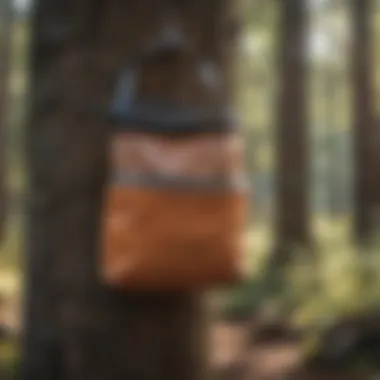Comprehensive Guide to Bear Bag Food Storage


Intro
In the realm of outdoor activities, engaging with nature entails a host of responsibilities, particularly in environments inhabited by wildlife. Among these, managing food storage in bear-prone areas stands as a pressing concern for both recreational adventurers and forestry professionals. Improper food storage not only jeopardizes human safety but also poses grave risks to bears, making it crucial to adopt effective strategies. This guide is structured to equip readers with the necessary knowledge about bear bag food storage practices and their broader context within woodland ecosystems.
Preface to Bear Bag Food Storage
Effective food storage in wilderness settings is essential to ensuring safety for both humans and wildlife. The practice of using bear bags plays a pivotal role in minimizing bear encounters while preserving the natural behavior of these animals.
Understanding the Importance of Food Storage
Storing food properly is not just about convenience; it is a vital safety measure. Bears have a keen sense of smell. They can detect food from miles away. If food is left unsecured, it attracts bears and increases the risk of dangerous encounters. Proper food storage disrupts this pattern. It helps keep bears in their natural habitat, avoiding unwanted interactions. This benefits both humans and bears, allowing each to coexist more safely.
Moreover, improper food storage leads to habituation. When bears find food easily accessible, they begin associating humans with food sources. This can create a cycle where bears become increasingly bold, leading to more frequent encounters. By employing proper food storage techniques, hikers and campers can mitigate these risks, cultivating a safer outdoor environment.
Overview of Bear Behavior
Understanding bear behavior is crucial for creating effective food storage strategies. Bears are opportunistic feeders and eat a variety of foods. Their diet varies based on the season. In spring, they might seek fresh greens, while in summer, they often forage for berries and insects. By fall, the focus shifts to high-calorie foods to prepare for winter hibernation. This constant search for food makes bears more likely to venture into campsites or hiking areas where food is improperly stored.
Bears explore their environment and can climb trees or even break into vehicles when prompted by food scents. Most encounters between bears and humans vary in severity. However, the fundamental principle remains: reducing attractants decreases encounters.
To effectively manage bear interactions, understanding their behaviors regarding food procurement is essential. This knowledge informs best practices in food storage, reducing the likelihood of attracting bears to human activity.
"The only good bear is a bear that never learns to associate humans with food."
This phrase encapsulates the core objective behind responsible food storage. By preventing bears from learning these associations, everyone enjoys the outdoors safely.
Choosing the Right Bear Bag
Selecting the proper bear bag is pivotal for ensuring safety while camping or hiking in bear-populated areas. The choice of bear bag can significantly influence how effectively food is stored and how well it deters bears from approaching campsites. A reliable bear bag will not only keep food secure but also reduce the likelihood of unwanted wildlife encounters. It is prudent to consider various elements, including material durability, bag sizes, and capacity.
Materials Used in Bear Bags
The materials that compose a bear bag are of utmost importance, as they dictate the strength and functionality of the bag. Common materials include nylon, ripstop fabrics, and sometimes reinforced canvas. Each of these materials offers distinct benefits:
- Nylon: Lightweight and resistant to water, nylon bags are easy to carry. However, the fabric may wear down if frequently used without care.
- Ripstop Fabric: This material features a special weaving technique that makes it tear-resistant. Ripstop is particularly valuable in the wilderness, where environmental elements can cause premature damage.
- Canvas: While more heavy-duty, canvas bags may retain water and become cumbersome over time. They are less commonly used for bear bags but can offer significant resistance to tearing and puncturing.
When selecting a bear bag, understanding the properties of each material can lead to a more informed purchase. The effectiveness of a bear bag is compromised if it cannot withstand the elements or sharp claws.
Sizes and Capacities
Bear bags come in various sizes and capacities to cater to different needs. Fitting your storage to your specific scenario is essential. A small bag may be sufficient for a solo camper with minimal food, but larger groups may require more space.
- Small Bags (5-10 liters): Ideal for short trips or solo hikers. These bags typically accommodate essential food items and snacks.
- Medium Bags (10-20 liters): Suitable for small groups or multi-day hikes. They provide extra room for additional food supplies and cooking tools.
- Large Bags (20+ liters): Designed for extensive camping expeditions or family outings. They can carry substantial quantities of food including cooking equipment.
The capacity of the bear bag you choose also correlates with its weight. Heavier bags are often sturdier but may complicate transport. Therefore, finding a balance between size, capacity and weight is crucial for effective food storage and comfort during outdoor activities.
Tip: Always consider your group's needs and the duration of your trip when selecting a bear bag. This ensures that you have adequate space for all your necessities while maintaining manageable weight.
Techniques for Effective Food Storage
Proper food storage is vital in preventing dangerous encounters with bears and ensuring safety during outdoor activities. Implementing effective techniques significantly reduces the chances of attracting wildlife, especially in bear territory. Understanding these techniques not only helps safeguard food but also plays a crucial role in protecting the delicate balance of ecosystems where humans and wildlife coexist.
Preparing Food for Storage
Preparing food for storage begins well before the camping trip. Before setting out, consider repackaging food items into smaller portions. This minimizes the amount of food that needs to be stored at camp. Opt for resealable bags or vacuum-sealed containers when possible. It helps keep food fresher and reduces odors that could attract bears.
Tip: Avoid bringing foods with strong scents, such as garlic or fish.


When cooking, always clean cooking utensils and surfaces immediately after use. Leftover food particles and residues can attract bears if not disposed of properly. It is also essential to store any food waste in a bear-proof manner as soon as possible.
Proper Bagging Techniques
The technique of bagging food correctly is crucial for effective bear bag storage. Use bags labeled as bear-proof or those specifically designed for this purpose. Bear-resistant bags are often puncture-resistant and constructed from heavy-duty materials.
Ensure that you remove as much air as possible from the bags before sealing them. Vacuum sealing is highly effective because it eliminates odors, making it less likely for bears to be drawn to your camp. Keep in mind, it is important to label all storage bags clearly, which becomes an essential practice for avoiding accidental mix-ups or consumption during your trip.
Hanging and Securing Bear Bags
Once food is properly prepared and bagged, the next step involves hanging the bear bags securely. This method is one of the most effective ways to deter bears from accessing your food. Choose a sturdy tree branch that is at least 10 feet above the ground and 4 feet away from the tree trunk. Use a rope that is strong enough to support the weight of the food bags without breaking. The rope needs to be tied in a way that allows for easy retrieval but is complex enough to prevent wildlife from reaching it.
When hanging the bear bag, make a loop using the rope, ensuring that the knot is secure. Hang multiple bags, if necessary, with separations to avoid potential noise from food packages bumping against each other. After securing the bear bag, check it occasionally to ensure that it remains stable and secure from animals attempting to reach it.
By implementing these techniques for effective food storage, outdoor enthusiasts can significantly lower the risk of bear encounters and enjoy their ventures into nature with confidence. Proper planning, preparation, and execution of food storage practices not only enhance safety but also contribute to responsible wildlife stewardship.
Bear Bag Regulations and Guidelines
Bear bag regulations are critical in outdoor recreation contexts. They serve as essential frameworks to manage human-bear interactions, particularly in areas where bear populations are significant. Guidelines help ensure both human safety and the well-being of wildlife. When properly adhered to, they minimize attractants that can lead to bear encounters, thus protecting both campers and bears.
National and State Guidelines
National guidelines, issued by agencies such as the National Park Service and the U.S. Forest Service, outline general practices for food storage in bear habitats. These guidelines vary slightly across different states, reflecting the diverse bear populations and behaviors across the United States.
They often emphasize:
- Proper food storage methods
- Recommended distances for hanging bags
- Mandatory use of bear-resistant containers in certain regions
These regulations represent an effort to create uniform practices that balance recreational use with wildlife preservation. Failure to comply with these guidelines may not only jeopardize personal safety but could also result in fines or other penalties.
Local Requirements in Popular Hiking Areas
Local ordinances can differ dramatically from broader state or national regulations. Popular hiking areas often have specific rules based on recent bear activity or historical data. Here are some key aspects:
- Specific Areas: Locations known for frequent bear sightings may require stricter food storage measures, like using bear canisters.
- Seasonal Regulations: Some areas may impose restrictions during certain seasons when bear activity increases, typically in the spring and fall.
- Education Programs: Local rangers often provide educational resources and information on the most effective food storage strategies.
Ignoring local requirements can lead to unnecessary conflicts with bears and negatively impact the environment. From a conservation standpoint, it is vital for recreationists to stay informed about the guidelines specific to the areas they plan to visit.
"Adhering to bear bag regulations is not just a legal requirement; it is a responsibility toward maintaining the delicate balance between human activities and wildlife habitats."
Following these guidelines is essential for not only individual safety but the safety of wildlife. Awareness and compliance can significantly reduce human-bear conflicts, preserving the wildlife experience for future generations.
Environmental Impact of Food Storage Practices
Understanding the environmental impact of food storage practices is essential, especially in areas inhabited by bears. The way humans store food influences not only the bear population but also the entire ecosystem. Proper food storage, particularly using bear bags or canisters, helps in maintaining wildlife's natural behavior. When food is stored incorrectly, it attracts bears and can lead to negative consequences. Therefore, promoting responsible food storage practices can protect wildlife and contribute to ecological balance.
Impact on Wildlife
When food is not stored correctly, bears can become accustomed to human food sources. This behavior may lead them to approach campsites more frequently, seeking food. Such habituation can be detrimental to both bears and people. Bears that learn to associate humans with food may lose their natural wariness, increasing the potential for dangerous encounters. Additionally, human-raised bears can disrupt local ecosystems. They may prey on smaller wildlife or encroach upon areas where they traditionally would not go, disrupting feeding patterns and breeding.
Adopting effective food storage methods contributes positively to wildlife conservation.
- Natural Feeding Habits: When bears rely on their natural food sources, they engage in normal behaviors, such as foraging. This helps sustain insect and plant populations, which in turn supports broader biodiversity.
- Population Control: Effective food storage can stabilize bear populations, preventing overpopulation in campsites and surrounding areas. When bears enter urban spaces seeking food, this can lead to increased culling or relocation efforts, which are often not sustainable solutions.
To emphasize these points:
"Proper food storage not only protects human interests but also honors the integrity of wildlife habitats."
Reducing Human-Wildlife Conflicts
Human-wildlife conflicts often arise from improper food storage. These conflicts pose risks not only to campers but also to bears and other wildlife. Reducing these encounters can enhance safety for all involved.


- Education and Awareness: Many incidents can be avoided through education on food storage. Increasing awareness of the correct practices can significantly decrease the likelihood of bear encounters. Understanding how to use bear bags and canisters effectively plays a crucial role.
- Community Initiatives: Engaging local communities in bear safety training fosters a cooperative approach to wildlife management. Programs that provide skills and knowledge about proper food storage can significantly reduce incidents.
- Policy Enforcement: Stricter regulations and enforcement of food storage policies in high-traffic areas can mitigate risks. Ensuring compliance with food storage guidelines helps uphold public safety and animal welfare.
Common Mistakes and Misconceptions
When it comes to managing food storage in bear-prone areas, understanding common mistakes and misconceptions is crucial for mitigating risks. Misunderstandings can lead to improper practices, inadvertently increasing the chances of attracting bears. This section examines two prevalent errors: over-reliance on bear canisters and failure to secure food properly. Addressing these issues is vital for safer outdoor experiences.
Over-Reliance on Bear Canisters
Many outdoor enthusiasts place undue faith in bear canisters, assuming they are impermeable solutions to bear encounters. While bear canisters provide significant security for food storage, they have limitations. Proper use of these canisters involves selecting the right size and ensuring the lid seals tightly. Some individuals neglect to consider that canisters may still attract curiosity due to their smell.
Bear canisters are indeed effective, but they are not a panacea. Using them improperly can diminish their effectiveness. Here are a few considerations:
- Not Ventilating: If food items are placed inside a canister without consideration of ventilation, odors can intensify, attracting bears.
- Improper Placement: Leaving bear canisters too close to sleeping areas or communal spaces can invite bears in. Proper placement away from campsites is essential.
It's also worth noting that bear canisters can be heavy and may not suit all hiking needs. They should not be the sole method of food storage. Combining bear canisters with techniques such as hanging food bags can enhance overall safety in the woods.
"Bear canisters are helpful but must not be relied upon as the only line of defense."
Failure to Secure Food Properly
Another common misconception in bear safety is the underestimation of securing food. Some individuals think that simply placing their food in a bear bag is sufficient. Inaccurate assumptions can lead to tragic results.
To secure food effectively, it is important to follow these guidelines:
- Hanging Techniques: Knowing how to hang a bear bag correctly is crucial. Aim for a height of about 10-15 feet above ground and at least 4 feet away from the trunk or branches.
- Checking Connections: Ensure that ropes or straps used to hang the bags are tightly secured. A loose or flawed connection can lead to food falling, making it accessible to bears.
- Double-Checking Location: Securing food at a distance away from your camp is necessary. Bears can travel distances and will remember successful food retrieval spots.
Many outdoor enthusiasts tend to overlook these factors, causing complications that can attract bears. A brief oversight, such as failing to secure food properly, can lead to serious consequences, endangering not only human life but also bear populations. A comprehensive understanding and commitment to secure food storage practices are essential for any outdoor adventurer in bear territory.
Alternatives to Bear Bags
The importance of considering alternatives to bear bags in food storage cannot be underestimated. While bear bags are effective, they are not the only solution available. Exploring these alternatives provides options that may be more suitable depending on specific camping situations or personal preferences. Understanding the characteristics and benefits of these alternatives ensures that outdoor enthusiasts can make informed choices for safe and effective food storage when in bear territory.
Bear Canisters
Bear canisters are robust containers designed specifically for storing food and other scented items securely. They offer several advantages over traditional bear bags:
- Durability: Made from high-strength materials, bear canisters resist bear attempts to open them. This feature is especially crucial in areas with high bear activity.
- Accessibility: Unlike bear bags, which require hanging at a certain height and distance, canisters can be placed on the ground, making them easier to access during meal preparation.
- Compliance: Many national parks require the use of bear canisters in certain areas, making them a necessity for some outdoor adventurers.
While bear canisters are heavier than bear bags, their reliability often outweighs their weight disadvantages. Users should choose a canister that meets the specific needs of their trip, factoring in level of bear activity and configuration of the camping site.
Electric Fencing Solutions
Electric fencing solutions present another innovative alternative for preventing bears from accessing food. These systems use a simple electric wire to create a barrier around a campsite or food storage area. Consider the following aspects of electric fencing:
- Effectiveness: Electric fences have been shown to be highly effective in deterring bears due to their negative experience when they try to cross.
- Portability: Many modern electric fencing units are lightweight and easy to transport, making them a practical option for camping trips.
- Versatility: Electric fences can protect not only food but also other scented items and even personal belongings.
Before using electric fencing, it is important to understand local regulations regarding their use in wilderness areas. Proper setup and maintenance are crucial to ensure effectiveness. Additionally, users should be knowledgeable about how to handle the equipment safely.
In summary, exploring alternatives to bear bags enhances preparedness and safety while enjoying the outdoors. Each option, whether bear canisters or electric fencing, comes with specific benefits and considerations. Evaluate these choices carefully based on personal needs and environmental factors to implement the best practices for food storage in bear country.
Best Practices for Camping and Hiking
The significance of establishing best practices while camping and hiking cannot be understated. Such practices greatly enhance not only individual safety but also the integrity of the natural environment. It becomes essential to understand the importance of thoughtful setup and precise food management. The following sections detail effective techniques that will benefit any outdoor enthusiast, especially in bear-prone areas.
Setting Up Camp Safely
When selecting a site for camping, safety should be paramount. The chosen area should be far from animal trails and away from dense berry patches that might attract bears. A good campsite is typically located at least 200 feet away from water sources to prevent any contamination. Flat ground is ideal, ensuring a secure sleeping surface. Proper elevation is also crucial, as it helps avoid flooding during unexpected rain.


Consider the wind direction when positioning your camp. Setting up in a way that allows your cooking area to be upwind from your sleeping area will reduce the chance of food odors attracting wildlife. This distancing is especially vital in bear territory, where a well-placed camp can make all the difference in terms of encounters. Campers should also have bear-safe equipment readily available, such as bear bags or canisters, to store food and trash securely.
"Safety begins before setting foot in the wild; it is in the planning and preparation phase that the groundwork for security is established."
Encourage good campsite cleaning practices to avoid leaving behind food scraps. This not only keeps your immediate area clean but also discourages wildlife from associating campgrounds with easy food access.
Food Preparation and Cooking
Food preparation and cooking processes require careful planning and execution to minimize risks. It is vital to follow best practices to ensure safety from wildlife encounters. When preparing meals outdoors, choosing to pre-package or prepare food at home helps limit the potential for attracting animals. This practice reduces the amount of food smell released into the environment.
Utilizing portable stoves instead of open flames can further mitigate the risk of attracting bears. Fire causes smoke, which can carry food scents over considerable distances. After cooking, cleaning pots and dishes immediately reduces odors that can linger and attract wildlife. In addition, storing leftover food promptly and correctly minimizes exposure. Always use bear-proof bags or containers to securely store any leftovers.
When hiking, it is essential to pack meals that can be consumed cold or require minimal cooking. Minimizing cooking time can significantly lower the smells produced. Moreover, maintaining a clean cooking area after each meal will establish good practices that protect both campers and bears.
By adhering to these best practices, campers enhance their chances of having a safe and enjoyable experience while minimizing negative interactions with wildlife. Balancing human enjoyment with environmental respect leads to a more harmonious coexistence.
Emergency Preparedness and Response
Being prepared for an encounter with a bear is essential for anyone spending time in bear-prone areas. The unpredictability of wild animals means that having a plan can significantly reduce risk. Understanding potential bear behavior and knowing the appropriate response can make a crucial difference in safety.
Emergency preparedness is not just about having equipment. It includes being aware of your surroundings and understanding bear dynamics. This knowledge can help prevent a bear encounter in the first place. For example, hiking in groups and making noise can deter bears. Additionally, knowing when to use your bear bag system effectively contributes to a safer experience in the wild.
Moreover, effective emergency response strategies can mitigate the consequences of an unexpected encounter. Individuals need to stay calm, assess the situation, and react accordingly. The benefits of preparedness can be life-saving. A seamless integration of practice and knowledge helps you maintain composure. Ultimately, we should not only focus on avoiding encounters but also how to respond adequately if they occur.
What to Do If Encountered by a Bear
If you find yourself face-to-face with a bear, your response should depend on the type of bear and the situation.
- Stay Calm: It is vital not to run. Bears can sprint at remarkable speeds and could see you as prey.
- Assess the Bear: Identify whether it is a black bear or a grizzly bear. Their behavior patterns may differ.
- Make Yourself Known: Speak softly, moving slowly and deliberately. This can help the bear recognize you as a person, not a threat.
- Back Away Slowly: Do not turn your back on the bear. Maintain a calm demeanor as you slowly retreat.
- For Grizzlies: If a grizzly bears down on you, make yourself look larger. Stand your ground and speak firmly. In the event of an attack, playing dead can be effective.
- For Black Bears: If a black bear charges, do not play dead. Instead, respond aggressively to establish dominance, as they may back off.
Important: Never attempt to climb a tree to escape. Bears can climb faster than you.
Reporting Bear Activity
Reporting bear activity is a critical component of maintaining safety in wilderness areas. When bears wander close to human habitats or frequently appear on trails, they pose a potential risk to both humans and wildlife.
To report an encounter:
- Document Details: Note the time, location, and behavior of the bear. This information is valuable for wildlife authorities.
- Contact Appropriate Authorities: Depending on your location, report your findings to the local park rangers or wildlife management agencies.
- Use Technology: Apps or websites dedicated to bear monitoring can provide platforms to share encounters with others.
Being vigilant and proactive contributes to overall public safety. When authorities receive timely reports, they can implement measures to manage bear populations or educate the public, reducing future encounters.
Future Trends in Bear Safety and Food Storage
As outdoor activities increase in popularity, understanding future trends in bear safety and food storage becomes crucial. It is not merely about keeping food secure; it also involves enhancing safety for both campers and bears. This section looks at emerging technologies and community initiatives that could significantly change how food storage is managed in bear habitats.
Emerging Technologies
The rise of technology presents new opportunities in bear safety measures. Various innovative products have been developed to enhance food storage and deter bear encounters. These include:
- Smart Bear Canisters: Some companies are creating bear-resistant containers equipped with GPS tracking. This advancement allows outdoor enthusiasts to monitor the location of their food storage in real-time.
- Ionizing Bear Deterrents: Specific devices now emit harmless ion molecules that can deter bears effectively. These devices can be placed near campsites to prevent bears from approaching, thus ensuring food safety and enhancing overall safety.
- Mobile Apps for Bear Awareness: Technology also plays a role in education. Several mobile applications provide real-time information on bear activity in various regions. Users can receive alerts about bear sightings, which can aid in planning safe camping trips.
These technologies address the need for safer outdoor experiences. As these tools become more widely used, their role in decreasing bear encounters will likely increase.
Community Initiatives and Awareness Programs
Community-driven initiatives play a vital role in promoting bear safety. Education and awareness are key components in reducing human-wildlife conflicts. Some noteworthy programs include:
- Local Workshops: Many outdoor organizations host workshops to educate campers on how to store food properly. These events often include practical demonstrations alongside informative sessions.
- Public Service Campaigns: Various states have launched campaigns aimed at raising awareness about bear safety. These efforts inform the public about best practices for food storage and the ecological importance of preserving bear populations.
- Partnerships with Schools: Some areas are introducing educational programs in schools to teach children about local wildlife and the importance of food storage in preventing bear encounters. By instilling knowledge from an early age, communities foster a greater respect for nature.
"An informed camper is the best defense against bear encounters."
As these community initiatives gain traction, the potential for reduced bear encounters will likely increase. Engaging the public through education is essential to achieving long-term success in bear safety efforts.
In summary, these trends illustrate a growing acknowledgment of the importance of bear safety and effective food storage. Emerging technologies provide practical solutions, while community initiatives foster widespread awareness. Together, they form a comprehensive strategy for ensuring safer outdoor experiences for all.







